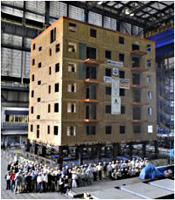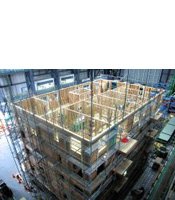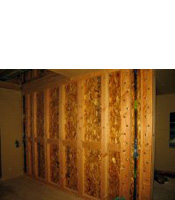What’s New
Shake table test of a seven-story wooden structure was conducted using E-Defense
NIED and the NEESWOOD (Project Leader: John W. van de Lindt, Professor at Colorado State University) carried out experiments on a seven-story wooden structure using the world's largest shaking table, E-Defense, during the period of June 22nd to July 20th. This research was a part of the international collaboration programs between the NEES (George E. Brown, Jr. Network for Earthquake Engineering Simulation) of the National Science Foundation (NSF) and NIED.Three researchers; Dr. Chikahiro Minowa, Dr. Izumi Nakamura, and Dr. Hidemaru Shimizu represented the NIED.
The purpose of this full-scale test was to verify the seismic performance of a seven-story wooden building under a large scale earthquake, and to obtain data which can contribute to the study for the development of taller wooden structures. The specimen used for the test was of a wood frame structure (called “Two-by-Four structure” in Japan), which is the most common building type in North America.
The specimen was a seven-story building with the first story served as commercial space for retail stores.This first story was a steel moment frame designed by Simpson Strong Tie, while the second to seventh floors were light-frame wood structure. The specimen was approximately 12.8m by 18.4m, and 20.4m in height. Because it was assumed that this structure would be constructed in the United States, many of the nails and OSB panels, etc. used for the specimen were imported from North America via 19 shipping containers.
The test was carried out for three days; June 30th, July 6th and July 14th. The test on July 14th was open to the public. Approximately 500 people, including visitors from foreign countries such as the United States, Canada, China, South Korea, and India attended the test.The open test was carried out by amplifying the acceleration waveform observed at Canoga Park recording station during the Northridge Earthquake of 1994 by 180%.With the main shaking direction being longitudinal to the specimen, the maximum acceleration of the input wave was 742Gal (short direction 628Gal and vertical direction 863Gal). This is approximately 80% the acceleration of gravity in the longitudinal direction. The specimen was severely shaken during the test, but its structural members were not seriously damaged. Only damage to non-structural elements was observed, i.e. drywall cracking, which was also felt to be quite moderate compared with the level of shaking.
The results of this study will be presented at domestic and foreign conferences by the NEESWOOD project team. They will be used for the purpose of conducting structural studies related to future extension of wooden structures in Japan, thereby broadening the wood market in both US and Japan.



